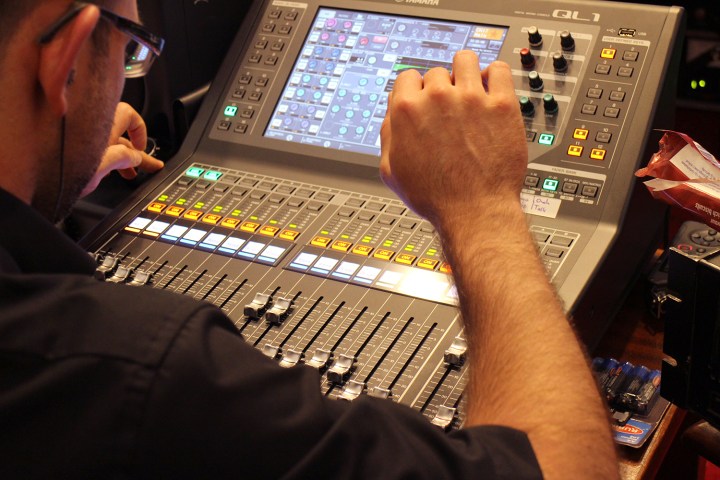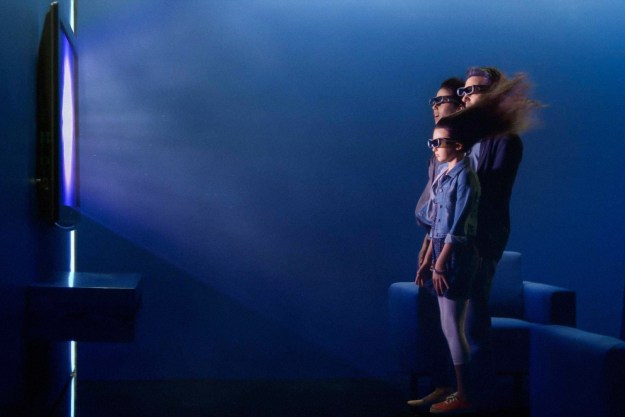
For many of us, simply hearing music and movie soundtracks isn’t enough.
We want to be there — on the battlefield with the soldiers, in the recording studio with the musicians, or smack in the middle of the the crowd at a live concert. Over the past few decades, the recording and home audio industries have endeavored to deliver that feeling to us with increasingly advanced recording methods and home hardware, but as realistic as the experience has become, technology thus far has struggled to thrust us beyond the two-dimensional realm and into a three-dimensional sound experience so real, you forget you’re sitting in your living room.
Until now. What I just heard at an exclusive event in London has me convinced that German audio outfit, Sennheiser, has helped crack the code.
London bridges
To celebrate its 70-year anniversary, Sennheiser invited journalists and musicians from across the globe to a premiere event at Westminster Central Hall in London. The big reveal? A mysterious — yet clearly luxurious — audiophile headphone system, which was teased for mere moments before it was gone as quickly as it came.
OK … now what?
Following the brief product spotlight would be a concert featuring Imogen Heap with the Junge Deutsch Philharmonie orchestra — the artist’s singular performance for the year. And while at first it seemed the concert was little more than fanfare for the event, a slew of microphones spread throughout the concert hall would tell a different story.

Before the music began, Sennheiser informed us that the concert would be recorded — for the first time ever — using an immersive new audio format called Sennheiser 3D (it’s a working title.) The concert commenced, and, for the majority of the attendees, the tale ended there. But after a bit of finagling, I managed to score a backstage look at this new 9.1-channel, 3D system in action, courtesy of Sennheiser’s Wolfgang Fraissinet, and Grammy Award-winning audio engineer and Senior Manager of System Design and Recording Strategic Collaborations Gregor Zielinsky.
Not just more channels
Zielinsky pulled back the curtain, revealing nine powered monitors set up in a proprietary pattern that aims to replicate all the nuances, reflections, and voicing of a live show. Matched with advanced recording techniques, the new audio system promised to bring the recorded concert to life through 3D imaging. And after being successfully tricked into believing I was surrounded by a live audience in a large hall rather than a tiny sound room, I can attest that Sennheiser’s new format offers scary-real results.
“We only need these nine speakers to reproduce the whole atmosphere of a hall.”
“The basic idea of 3D, or 9.1 is not just an extension of 5.1 or 7.1 [surround sound], because these are all two-dimensional,” Zielinsky tells us. “3D, as you can see, is three-dimensional, and we only need these nine speakers to reproduce the whole atmosphere of a hall … because the ear somehow compensates all the rest.”
Unlike Dolby Atmos, or DTS:X surround systems, Sennheiser 3D doesn’t employ overhead speakers mounted on the ceiling. Instead, the setup relies on two pairs of height speakers at the front and the back of the room that recreate the reflections of the sound waves bouncing off the ceiling of the concert hall, in company with front left, right, and center channel speakers, and rear left and right speakers. It’s a simple design, but in practice, it’s quite impressive.
Resurrecting live sound
“The basic idea is (to) bring back the sound — and especially the emotional feeling — that you have in the hall,” Zielinsky says. “In stereo and 5.1 two-dimensional sound, we are losing all this … and you cannot bring this back.”

Zielinsky, who has recorded everywhere from Vienna’s Muzicverein concert hall to Abbey Road Studios, likens the difference between standard recording and Sennheiser’s new method to the difference between looking through a slot in a door, and opening the door and walking into the room. Using as many as 60 separate microphones, the engineers captured an incredible amount of sonic information from the room.
An integral component to the recording lies in the use of a Zielinsky’s specialized setup for the main room mics, which trades the standard Left and Right microphones pointing straight at a stage for dual microphones on each side — one pointed up towards the ceiling, and one pointed down towards the floor — along with a single mic in the middle. The result of the entire process creates a massive sonic image, one layered with rich bass, natural reflection, and free from the so-called “sweet spot” reproduced by most standard surround sound formats.
“The bass comes by adding the phase correlations that finally give back the sound in the hall.”
“You can move around, and you will notice how the sound changes, like if you moved inside the hall, but (there’s) no sweet spot, in fact. None at all,” Zielinksy assured me. And following his dare, I did just that, wandering through the small room, half-tripping over the working engineers, and finding a remarkably open and natural sound stage that, true to Gregor’s word, remained clear and full virtually wherever I roamed within the hemisphere of monitors. Moreover, the full frequency spectrum was richly reproduced by the small
“We are not adding bass … it comes by adding the phase correlations that finally give back the sound in the hall,” Zielinsky adds. “And also, what’s really exciting is you don’t have to move around faders anymore — the instruments place themselves as they are naturally in the hall.”
But the real kicker came toward the end of the performance when I wasn’t focused on critical listening at all. When the audience applauded, for a split second my brain truly believed I was dead center in the concert hall, completely throwing me out of my own sense of being for a moment.
The future of 3D sound
Sennheiser’s burgeoning format isn’t just about live classical music recording, either. The company sees its new system as a perfect way to capture rock shows, movies and TV sound, gaming sound, and even sound for virtual and augmented reality systems. Sennheiser has also worked with both Dolby, and Auro 3D systems to bring its new 3D audio recording format into homes on Blu-ray, and through other means. And using DSP, those who only have stereo home theater systems or headphones will be able to get a taste of Sennheiser 3D as well, though the sound obviously won’t be as natural as a full 9.1 setup.
With 70 years at its back, there’s no doubt that Sennheiser is still innovating, with the help of some of the best audio minds in the business. While there’s no premiere date for Sennheiser 3D yet, the system is on the way. And we can’t wait to get more hands on time with it to see just how far this new setup can go to place us all at the center of the sound.
Editors' Recommendations
- You Asked: 3D VR, QDEL technology, and TV size vs. quality
- Samsung, Google are attacking Dolby Atmos’ monopoly on 3D sound, and it’s going to get ugly
- 3D-printed eartips could mean way more comfortable and better-sounding earbuds
- Los Angeles-based Czinger is 3D-printing a 1,232-hp hybrid hypercar
- It’s time to enlist your 3D printer in the fight against coronavirus






